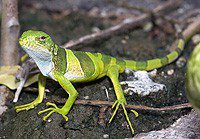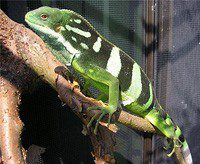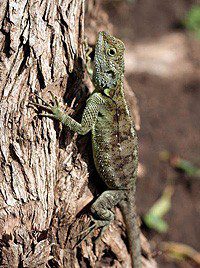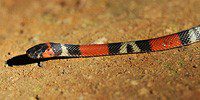
Fijian iguana
Among the iguanas living on the Fiji Islands, three species are known – the spotted bellied Fijian iguana (Brachylophus vitiensis), the striped iguana (Brachylophus fasciatus) and the recently discovered species Brachylophus bulabula, the second part of the foreign name of which in the Fiji dialect means “hello hello”. All Fijian iguanas are considered rare and even endangered, therefore, for protection, they are listed in the IUCN Red List and Appendix 1 of the CITES Convention, and also declared a national treasure of the Republic of Fiji. Why are Fijian iguanas endangered? The fact is that for local residents they have not only the “poetic” meaning of the republican symbol, but also quite prosaic – delicious food. But besides humans, Fijian iguanas have many other enemies, such as cats and mongooses. Yes, and active economic activity reduces their habitats. Therefore, today people began to engage in artificial selection of Fijian iguanas, fortunately, they breed well in captivity. Interestingly, representatives of the iguana family survived only on two islands of Oceania – Fiji and Tonga. Moreover, certain species of Fijian iguanas, in particular, spotted-bellied, do not live on all, but only on some of the islands of Fiji. For more details, see the Distribution and Habitat section.
Contents
Classification
Kingdom: Animals
Type: Chord
Class: Reptiles
Order: Scaly
Suborder: Lizards
Family: Iguana
Genus: Brachilophus
Species: Spotted Iguana, Striped Iguana, Brachylophus bulabula
Appearance
 Since there are only three types of Fijian iguanas, we will dwell on each of them in a little more detail. But first, the general features of these iguanas should be noted. In particular, they have markedly pronounced sexual dimorphism. Males have a clear pattern of stripes and spots on the body, as well as a brighter general coloration. Females are more uniform. Spots on the skin of Fijian iguanas are usually lighter than the main tone of the body, they are distributed over the entire surface of the body, including on the head. Fijian iguanas also have a horny comb. In some species it is more pronounced. And all Fijian iguanas are endowed with sharp claws, tenacious paws and a long tail – all these qualities are due to their arboreal lifestyle and help to move easily and quickly high from the ground.
Since there are only three types of Fijian iguanas, we will dwell on each of them in a little more detail. But first, the general features of these iguanas should be noted. In particular, they have markedly pronounced sexual dimorphism. Males have a clear pattern of stripes and spots on the body, as well as a brighter general coloration. Females are more uniform. Spots on the skin of Fijian iguanas are usually lighter than the main tone of the body, they are distributed over the entire surface of the body, including on the head. Fijian iguanas also have a horny comb. In some species it is more pronounced. And all Fijian iguanas are endowed with sharp claws, tenacious paws and a long tail – all these qualities are due to their arboreal lifestyle and help to move easily and quickly high from the ground.
The spotted-bellied Fijian iguana is perhaps the largest among all members of the family in Fiji. Its dimensions are up to 90 cm, and especially large individuals sometimes weigh a little less than half a kilogram. On the back of this Fijian iguana there is a horny comb, the scales of which are 1 cm long, and if the iguana is excited, the color of the comb can change from green to black. A change in the color of the ridge often speaks of aggression. If any enemy attacks the iguana, then a wide-open mouth is added to the black crest and active attacks begin in the direction of the enemy. Spotted belly this iguana is named for the color of the lower body, which is an olive skin covered with small light spots. And on the back and sides of the Fijian iguana, the spots are noticeably larger. And the differences between females and males of this iguana are not as pronounced as in other species.
The Fijian striped iguana does not have such a high comb. But it is distinguished by an emerald skin color with wide blue stripes and lighter lemon-colored toes on its paws. And the striped iguana has amazing eyes – with a reddish-orange or golden-pink iris. These iguanas are smaller than the spotted bellies. And their body is less massive, more reminiscent of the body of a green iguana, from which, according to some scientists, the Fijian iguanas are descended. In general, these lizards have a very spectacular coloration with a predominance of green and blue with a tint.
Brachylophus bulabula looks more like a striped than spotted Fijian iguana. She has the same small crest, but the color is more pistachio green on the back and gray-green on the belly, and the spots and stripes on the body are white.
Young Fijian iguanas in almost all of the above species are born dark green and gradually acquire the main color over several hours.
Distribution and habitation
All Fijian iguanas are endemic to the Fiji Islands. For example, spotted bellied lizards today can be found mainly on the island of Yadua Taba, and earlier they lived in large numbers on Monuriki. According to modern estimates, the total number of spotted iguanas in Fiji is about 9 individuals per hectare. The total number of all species of Fijian iguanas on Yadua Taba is larger, about 6000 individuals, and only 1000 on Monuriki. This can be explained by the abundant vegetation of Yadua Taba, while goats graze on Monuriki, eating bushes and trees and thus depriving iguanas of food. Moreover, the territory of Yadua Taba includes not only one large island, but also smaller ones, among which there is the so-called Iguana Sacred Island – there is the largest concentration of various Fijian iguanas.
But striped iguanas settled not only in Fiji, but also on the islands of the kingdom of Tonga. Brachylophus bulabula, in turn, is the most geographically isolated species, choosing mainly the central and northwestern islands of the archipelago for its habitat.
 It is assumed that all iguanas came to Fiji from South America. More precisely, initially ordinary green iguanas moved to Oceania, which later evolved into Fijian ones. These reptiles prefer forest areas and less inhabited parts of the islands. Males – the main ones in any group according to the hierarchy – show dominance even in settling, trying to occupy the upper parts of the trees, while females and juveniles are located a little lower. The humid tropical climate of the islands is quite favorable for Fijian iguanas, and they can settle in various biotopes – in damp mountain forests, near swamps, and in coastal vegetation. But, unfortunately, the habitats of lizards under human influence are gradually shrinking, and this also puts the species at risk of extinction. By the way, from the point of view of discovery, more precisely, the first scientific description, Fijian iguanas can be called relatively young reptiles. They were first described in the 70s of the 20th century.
It is assumed that all iguanas came to Fiji from South America. More precisely, initially ordinary green iguanas moved to Oceania, which later evolved into Fijian ones. These reptiles prefer forest areas and less inhabited parts of the islands. Males – the main ones in any group according to the hierarchy – show dominance even in settling, trying to occupy the upper parts of the trees, while females and juveniles are located a little lower. The humid tropical climate of the islands is quite favorable for Fijian iguanas, and they can settle in various biotopes – in damp mountain forests, near swamps, and in coastal vegetation. But, unfortunately, the habitats of lizards under human influence are gradually shrinking, and this also puts the species at risk of extinction. By the way, from the point of view of discovery, more precisely, the first scientific description, Fijian iguanas can be called relatively young reptiles. They were first described in the 70s of the 20th century.
Behavior and lifestyle
Trees for Fijian iguanas are both home and main place of movement. These lizards may only go downstairs to move to a more suitable tree or make a clutch. The green body color of the Fijian iguanas allows them to camouflage themselves well in the foliage, although the lifestyle of reptiles is already quite secretive. The iguana will never approach a person, choosing places as far as possible from his habitation.
The behavior of lizards at first glance seems quite primitive – during the day they look for food and bask in the sun, or simply bypass their sites, protecting them from other people’s encroachments. The main guards of the territories are males, when they meet an iguana from an alien group that has wandered into their territory, they take an active defensive position, which is expressed in darkening of the skin and swelling of the throat folds. So Fijian iguanas try to scare the enemy.
In captivity, these lizards are unlikely to be found in a home terrarium, rather in South American zoos, where these reptiles are specially bred. Observing their life in captivity, breeders have identified several conditions in which Fijian iguanas can normally exist – this is good air exchange, suitable humidity and a sufficient amount of ultraviolet light necessary for cold-blooded reptiles. Already, the number of artificial populations of these lizards is gradually growing, and soon scientists hope that it can be compared with the natural one.
Food
Adult Fijian iguanas are herbivores. Their main food is what they find on trees – leaves, fruits and flowers. Iguanas especially love hibiscus flowers. Young individuals sometimes prey on insects, but adults finally become vegetarians. And yet, in captivity, the plant diet of Fijian iguanas is diluted with crickets, zoophobuses, and even small mice.
But what kind of diet for Fijian iguanas is recommended by experts: the lizard needs greens, it can be various salads. Vegetables and fruits are allowed from succulent feed, but not more than 15% of the total food. And of course, for the health of Fijian iguanas, vitamin and mineral supplements are simply necessary to regulate the ratio of calcium and phosphorus in the body of a lizard. In particular, there should be more calcium, and, for example, it is contained in the right quantities in dark lettuce leaves. Other calcium-rich plants are dandelion, clover, beetroot, pumpkin tops, radish leaves, parsley, spinach, lettuce, watercress. All this is easy to grow in your own garden. Very useful for Fijian iguanas and shoots of sprouted alfalfa. From vegetables, broccoli and carrots, pea pods and beans are suitable for feeding lizards. And from fruits, it is better to give preference to berries, for example, currants and blueberries, as well as citrus fruits.
The main thing is to keep a balance. The diet of the Fijian iguana should not be dominated by any one type of food, a little is best. And for lizards, you can grow home plants, for example, tradescantia and nasturtium, begonia and hibiscus. Fijian iguanas do not refuse the petals and leaves of domestic roses and dahlias, and even some types of cacti, previously cleared of thorns. Cereal products are also useful for reptiles. Of the most accessible to them – grain bread, bran and brewed oatmeal, as well as buckwheat and rice porridge, of course, without any addition of salt and fat, on the water. As for exotic fruits, they are also allowed to feed the animal little by little. It can be mango, papaya, avocado or banana.
Reproduction
 The reproduction of all types of Fijian iguanas, of course, has common features, since they are all, in fact, relatives. But, of course, there are differences. Consider spotted iguanas. They already start mating in January, accompanied by special courtship of the male. And in March, the female lays a clutch of 4-6 red-orange or golden eggs. The mother iguana carefully guards her nest. And the incubation period for spotted Fijian iguanas is the longest compared to other species. It is about 8 plus months. The young of these lizards are usually born during the rainy season. Newborn offspring need moisture, so babies get it by licking raindrops from nearby hanging leaves.
The reproduction of all types of Fijian iguanas, of course, has common features, since they are all, in fact, relatives. But, of course, there are differences. Consider spotted iguanas. They already start mating in January, accompanied by special courtship of the male. And in March, the female lays a clutch of 4-6 red-orange or golden eggs. The mother iguana carefully guards her nest. And the incubation period for spotted Fijian iguanas is the longest compared to other species. It is about 8 plus months. The young of these lizards are usually born during the rainy season. Newborn offspring need moisture, so babies get it by licking raindrops from nearby hanging leaves.
Fijian striped iguanas also have their own mating ritual. The male, caring for the female, vigorously nods his head, the color of his body darkens, and then tenderness begins, in particular, feeling the neck, back and front paws of the chosen “girl” with his tongue. Striped Fijian iguanas breed a little earlier than spotted bellied iguanas – from November to January. There are about the same number of eggs in their clutch. And striped lizards are characterized by early puberty. In captivity, six months after birth, they begin to form pairs, while in nature the ability to reproduce comes to iguanas only at two years. Scientists observed the pairing of Fijian striped iguanas in enclosures and noted that it lasts 15 minutes and is repeated several (usually 4) times a day. In general, the courtship period takes a week. The female of these lizards, like the spotted-belly, guards the masonry herself.
The sex of offspring in all iguanas depends on the ambient temperature. The closer the hatching time of the young comes, the heavier the egg becomes.
But very little is known about the reproduction of the relatively new species of Fijian iguanas Brachylophus bulabula. Researchers suggest that its nature is similar to the breeding of striped lizards, which Brachylophus bulabula is most similar to.
Sources of
http://zooclub.by/
http://ru.wikipedia.org
http://www.zookrug.net
http://forum.zoologist.ru/
http://pda.privet.ru/
http://en.wikipedia.org/





